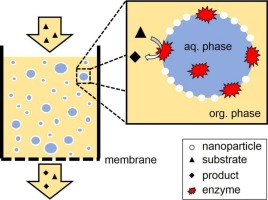Catalysis Today ( IF 5.2 ) Pub Date : 2017-12-02 , DOI: 10.1016/j.cattod.2017.11.032 Anja Heyse , Christoph Plikat , Marion Ansorge-Schumacher , Anja Drews

|
Pickering emulsions are currently receiving increased attention as a promising alternative to dispersions or surfactant stabilized emulsions in two-phase biocatalysis. In order to design a continuous membrane reactor using water-in-oil Pickering emulsions for biocatalysis, knowledge on the filterability of the Pickering emulsion is required. This can be influenced by a number of factors, e.g. type and size of stabilizing nanoparticles, applied solvent, and used membrane. In a previous application of water-in-oil Pickering emulsions for continuous biocatalysis in a membrane reactor, spherical silica particles were used to stabilize the emulsion. This resulted in densely packed filter cakes due to unbound residual particles and decreasing flux over time. Furthermore, rather large droplet sizes with small specific interfacial areas were achieved. In this work, the use of colloidal silica nanoparticle for the stabilization of bioactive Pickering emulsions was studied. The filterability of bioactive water-in-oil Pickering emulsions stabilized by spherical or colloidal silica nanoparticles was compared. Using colloidal silica nanoparticles was found to result in smaller emulsion drop sizes, higher filterability and better reproducibility of drop size distribution and flux. An increase in water volume fraction decreased the flux level, but filtration was still possible at industrially relevant fluxes. With the selected nanoparticles, continuous biocatalysis in a membrane reactor at constant flux, i.e. constant residence time, was performed twice for 30 h. Substrate and product concentrations were constant and reproducible and the enzyme was still active after 30 h. The productivity was higher than that obtained with spherical silica nanoparticles and the process duration is the longest so far reported for continuous biocatalysis in PE at industrially relevant residence times.
中文翻译:

在膜反应器中使用油包水型Pickering乳液进行连续两相生物催化:不同纳米颗粒的评估
作为两相生物催化中分散体或表面活性剂稳定的乳液的有前途的替代品,Pickering乳液目前正受到越来越多的关注。为了设计使用油包水型Pickering乳液进行生物催化的连续膜反应器,需要有关Pickering乳液可过滤性的知识。这可能受到许多因素的影响,例如,稳定化纳米颗粒的类型和大小,所用溶剂和所用膜。在油包水型Pickering乳液在膜反应器中进行连续生物催化的先前应用中,球形二氧化硅颗粒用于稳定乳液。由于未结合的残留颗粒和随着时间的流逝而减少的流量,导致滤饼密堆积。此外,获得了较大的液滴尺寸和较小的比界面面积。在这项工作中,研究了使用胶态二氧化硅纳米颗粒稳定生物活性Pickering乳液的方法。比较了球形或胶体二氧化硅纳米粒子稳定的生物活性油包水Pickering乳液的可过滤性。发现使用胶体二氧化硅纳米颗粒导致较小的乳液液滴尺寸,更高的过滤性和更好的液滴尺寸分布和通量的再现性。水体积分数的增加降低了通量水平,但是在工业上相关的通量下仍可以进行过滤。对于选定的纳米颗粒,在膜反应器中以恒定通量(即恒定停留时间)进行连续生物催化两次,持续30小时。底物和产物的浓度是恒定且可重现的,并且酶在30小时后仍然具有活性。











































 京公网安备 11010802027423号
京公网安备 11010802027423号